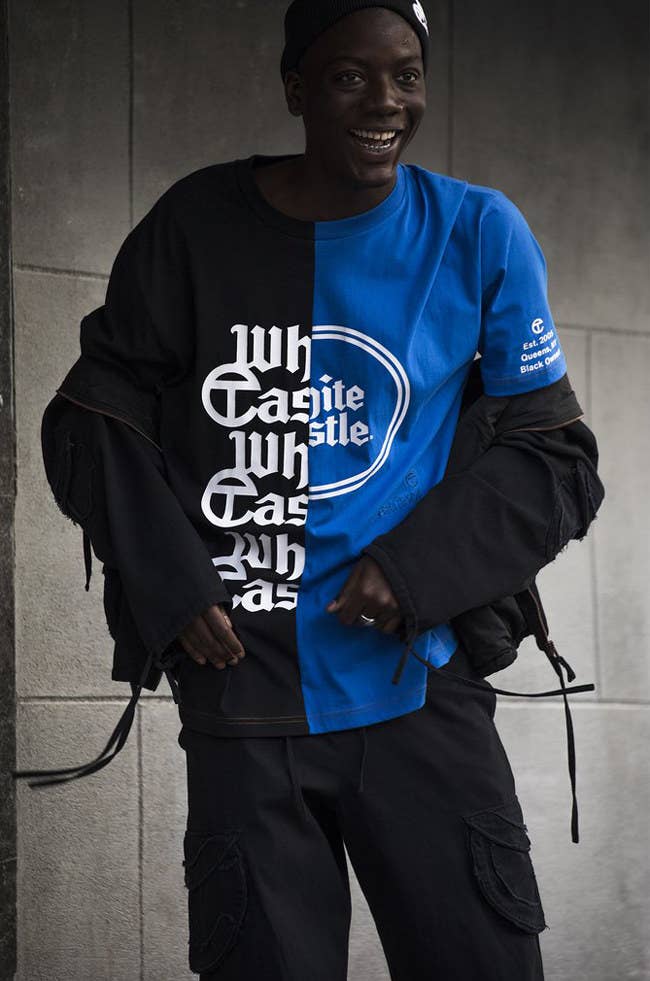Why Branded Clothing Made with Natural Fibers Feels Better
Why Branded Clothing Made with Natural Fibers Feels Better
Blog Article
Recognizing Clothes: The Value of Fabric Choices in Your Wardrobe
The choice of material in clothing plays a critical duty in both looks and capability. Different materials supply varying levels of toughness, comfort, and breathability, directly affecting the wearer's experience. Understanding these subtleties can enhance one's wardrobe markedly. Lots of neglect just how these choices can influence not just individual style, but additionally sustainability. What textile choices could redefine your wardrobe and straighten it with both design and obligation?
The Function of Fabric in vogue and Functionality

Typical Fabric Types and Their Features
When picking garments, recognizing the features of typical textile kinds is important for making informed choices. Cotton, a widely-used natural fiber, is understood for its gentleness, adaptability, and breathability, making it appropriate for sportswear and day-to-day garments. Linen, an additional all-natural choice, boasts superb moisture-wicking residential or commercial properties and a distinct texture, suitable for cozy climates.Wool, frequently preferred for its warmth and sturdiness, differs in fineness; merino wool is soft versus the skin, while coarser kinds are made use of for outerwear. Synthetic fabrics like polyester and nylon supply toughness and resistance to creases, making them prominent for activewear and traveling garments. Ultimately, blends, which combine synthetic and all-natural fibers, can boost performance while maintaining convenience. By recognizing these textile attributes, people can select apparel that lines up with their lifestyle and visual choices.
Breathability and Convenience: Picking the Right Fabrics for Different Environments
Choosing the ideal textiles for different climates can considerably improve comfort and total wearability. Breathable products are vital in warm environments, as they enable air blood circulation and wetness evaporation. Fabrics such as cotton, bed linen, and moisture-wicking synthetics properly draw sweat far from the body, keeping the user cool and completely dry. On the other hand, in chillier climates, thicker textiles like woollen or fleece provide insulation while maintaining breathability, making certain warmth without overheating.Additionally, the option of textile weight plays a vital duty; lightweight textiles are better for summer, whereas larger choices are matched for winter season wear. Comprehending the special homes of each fabric allows individuals to dress suitably for differing climate condition. Eventually, choosing comfortable and breathable textiles tailored to specific climates can considerably boost daily comfort and improve the general experience of using garments.
Toughness and Treatment: Just How Textile Impacts Durability of Your Closet
Picking the ideal materials can considerably impact the toughness and treatment needs of a closet. Fabrics such as cotton and polyester are understood for their durability and convenience of maintenance, making them excellent for day-to-day wear. On the other hand, fragile products like silk and shoelace need even more mindful handling and specialized cleaning approaches, which can enhance the time and effort required for care. Branded Clothing.Durability is additionally influenced by the textile's weave and finish; firmly woven fabrics have a tendency to stand up to damage far better than freely woven choices. Furthermore, synthetic blends frequently provide boosted durability, combining the finest qualities of multiple fibers.Understanding the care instructions for every textile is crucial, as inappropriate cleaning or drying can result in early wear. Inevitably, picking durable products can cause a longer-lasting wardrobe, decreasing the regularity of substitutes and adding to a more lasting style option
The Influence of Fabric on Fit and Shape

Sustainable Fabric Choices: Making Eco-Friendly Choices
The influence of textile expands beyond fit and shape to encompass ecological variables, triggering an expanding interest in lasting material options. Environment-friendly materials, such as organic cotton, hemp, and Tencel, are acquiring traction among customers that focus on sustainability in their closets. These materials are often generated with fewer chemicals and water, decreasing their eco-friendly footprint.Additionally, recycled materials, made from post-consumer waste, offer an innovative remedy to the textile sector's air pollution trouble. Brands increasingly embrace transparency in their sourcing methods, permitting customers to make educated choices regarding their purchases.Choosing lasting textiles not only sustains ethical techniques yet also urges the garment industry to take on even more accountable manufacturing techniques. As awareness of ecological problems climbs, people are advised to show on the lasting influence of their textile choices, promoting an activity in the direction of a more ecologically conscious and lasting technique to style.
Elevating Style: Just How Material Can Change a Clothing
While many may concentrate on shade and cut when picking an outfit, the selection of material plays an essential duty in boosting style and improving overall look. Different products share distinct moods and messages; for instance, silk emanates deluxe and elegance, while denim provides a laid-back, relaxed vibe. The appearance why not find out more and drape of a textile can considerably alter the shape, with organized fabrics supplying a sleek look and softer ones creating a more fluid, relaxed aesthetic.Moreover, the weight of the material influences wearability throughout periods. Lightweight textiles like bed linen and cotton are ideal for summer, while much heavier materials such as woollen and velvet supply heat and sophistication in cooler months. Understanding textile residential or commercial properties, such as breathability and stretch, also encourages people to make enlightened options that boost comfort without compromising style. Ultimately, the best fabric can change a clothing from ordinary to amazing, making it an important factor to consider in any type of wardrobe.
Often Asked Questions
Exactly how Do I Identify the Fabric Web Content of My Clothes?
To determine fabric content, one can take a look at treatment tags, conduct burn tests for fiber recognition, or speak with textile examples. These approaches help distinguish materials, making sure informed options for garments care and upkeep in day-to-day wear.
Can Material Selection Affect My Mood or Confidence?
Textile option can significantly affect a person's state of mind and self-confidence. Branded Clothing. Particular products may evoke sensations of comfort or style, while others can really feel unflattering or restrictive, inevitably affecting self-perception and emotional well-being throughout the day
What Fabrics Are Finest for Sensitive Skin?
For people with sensitive skin, natural materials like linen, cotton, and bamboo are usually recommended. These products are breathable, hypoallergenic, and less likely to trigger irritation, making them suitable selections for comfort and skin health.
Exactly how Do I Effectively Wash and Look After Various Fabrics?
To properly care and clean for different textiles, one should think about each material's details needs, consisting of temperature setups, cleaning agents, and drying out approaches, making certain longevity and maintaining the fabric's initial top qualities for perfect usage.
Are There Details Fabrics for Athletic or Performance Wear?
Athletic or performance wear often makes use of textiles such as polyester, nylon, and spandex. These products are designed for moisture-wicking, breathability, and flexibility, improving motion and convenience during exercises while offering resilience and support. Conversely, you could try this out in chillier environments, thicker materials like wool or fleece give insulation while retaining breathability, ensuring warmth without overheating.Additionally, the selection of textile weight plays a crucial duty; light-weight textiles are more suitable for summertime, whereas heavier options are suited for winter wear. In comparison, delicate materials like silk and shoelace call for more mindful handling and specialized cleaning techniques, which can enhance the time and initiative needed for care.Durability is also influenced by the textile's weave and coating; snugly woven materials tend to resist wear and tear better than freely woven alternatives. In contrast, inflexible materials can restrict activity however provide a traditional, refined look.Moreover, the density and appearance of the textile can influence the visual perception of body shape. The effect of textile prolongs past fit and shape to incorporate ecological variables, triggering a growing passion in lasting material selections. The appearance and drape of a fabric can dramatically change the shape, with structured fabrics giving a refined appearance and softer ones creating a more fluid, loosened up this post aesthetic.Moreover, the weight of the material affects wearability across periods.
Report this page